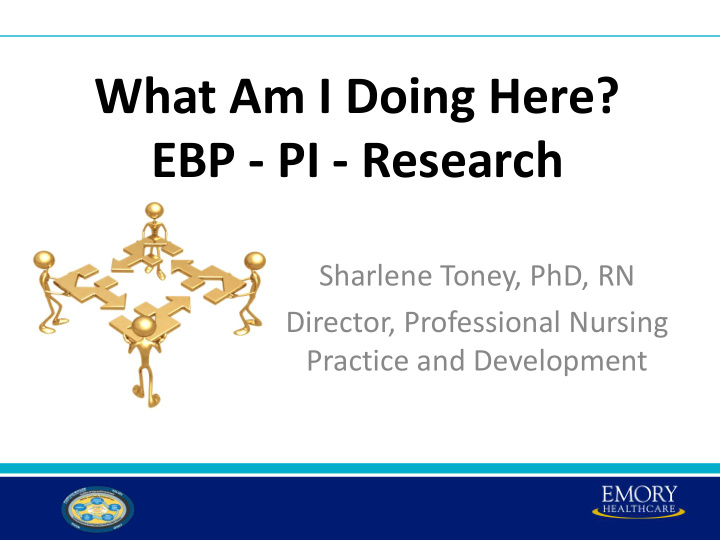



What Am I Doing Here? EBP - PI - Research Sharlene Toney, PhD, RN Director, Professional Nursing Practice and Development
Session Objectives: • Define evidence-based practice (EBP) • Identify the difference between Process Improvement and Research • Describe a decision model for EBP projects and Research • List two reasons supporting the use of EBP in nursing practice "Quality is never an accident. It is always the result of intelligent effort. " John Ruskin (1819-1900) English theorist 2
Professional Practice Model for EHC Nursing Be committed to both: Research and Process Improvement 3
Evidence-based practice is not a cook-book or cookie-cutter approach to developing or managing clinical practice. It requires a degree of flexibility and fluidity based on a firm scientific and clinical evidence validating appropriate and sustainable clinical practice Malloch , K., & Porter O’Grady, T. (2006). Introduction to Evidence-Based Practice in Nursing and HealthCare . Sudbury, MA: Jones and Bartlet Publishers.
Defining Evidence Based Practice • “The conscientious and judicious use of the best available evidence from a variety of sources to guide nursing care that is patient- centered and appropriate to the context of care.” Shapiro, 2007 • “… (EBP) is a problem -solving approach to clinical decision-making in healthcare that integrates the best evidence from well designed studies with a clinician's expertise, which includes internal evidence from patient assessment and practice data, and a patient’s preferences and values.” Sackett et al, 1996; Melnyk et al, 2011 5
Transdisciplinary EBP Model Adapted from Satterfield, et al. 2009 Best available research evidence Environmental and Decision-making organizational context Client/population Resources, including characteristics, professional expertise values, etc Model translates to clinical and leader EBP 6
How are they Different? Process Improvement Research • A systematic approach to help an • A scientific process that organization optimize patient care validates and refines existing processes to achieve better patient knowledge and generates outcomes (PDSA/PDCA; Lean, etc.) new knowledge that directly and indirectly influences • Research is a foundation for nursing practice developing a test of change (quantitative, etc.) process • Instruments : validity • Uses benchmark data (NDNQI, • Human subjects protection UHC, published in the literature, internal data) • Data: Statistical significance • Data: Trending, variation (quantitative research) • Process variations based on unit, • Generalizable population, shift, etc. • External evidence • Internal evidence
Model to Guide Review and Use of Evidence Slide used with permission from LBellury, (LBellury - 2010)adapted from Polit & Beck , 2009 & Titler, Kleiber, Steelman, et al., 2001 Problem Review of Evidence Enough Not Enough evidence evidence Create/Review Policy/Procedure EBP Conduct /Protocol Project Research Clinical Pathway/ Multidisciplinary Plan of Care Improved Outcome Research Staff Education Outcomes Process or Performance Patient Education Improvement Analyze process Try alternate plans to achieve improvement
EBP & Nursing Quality Internal evidence External evidence
EBP for Patient Experience Team including brief synthesis of the literature Published evidence supporting a best practice
JONA, November 2012 issue
Does your practice support this level of excellence?
• “… nurses support that engaging in EBP renews the professional spirit of the nurse, a key variable in professional satisfaction.” Maljanian et al, JONA, 2002 • “…EBP gives us a voice” and allows them to “reclaim their authentic self as a ‘real nurse’ as well as supports them to ‘become strong patient advocates, focused on improving the quality of the care given to patients.” Strout, TD (2005) Sigma Theta Tau 14
• “…Recognition that nursing knowledge is not static, but ever changing and improving, is the hallmark to excellence in patient care. Supporting a practice environment that questions if the care given is the best it can be is a win- win for everyone…” Bauer-Wu, Cooley, & Healey, 2005 15
Questions “Knowing is not enough; we must apply. Willing is not enough; we must do.” Goethe
Recommend
More recommend